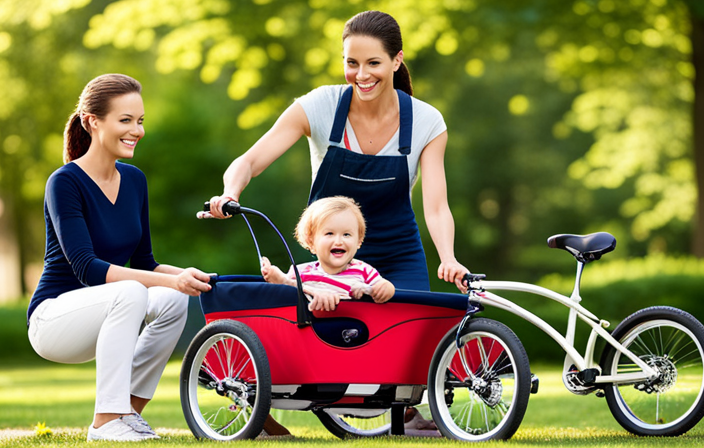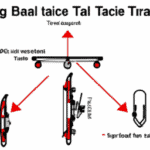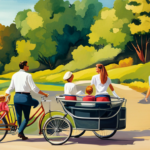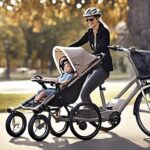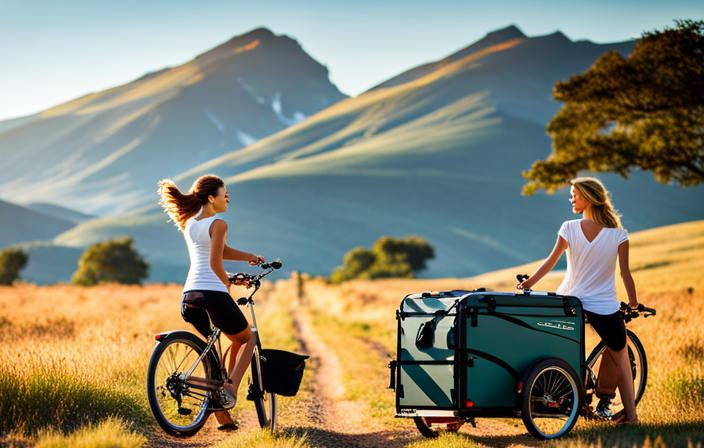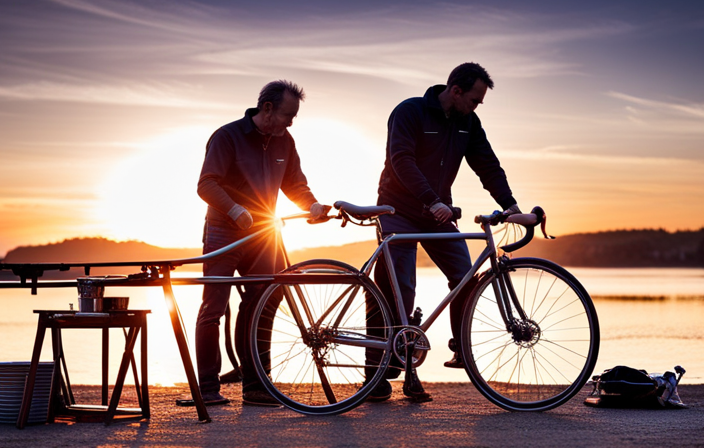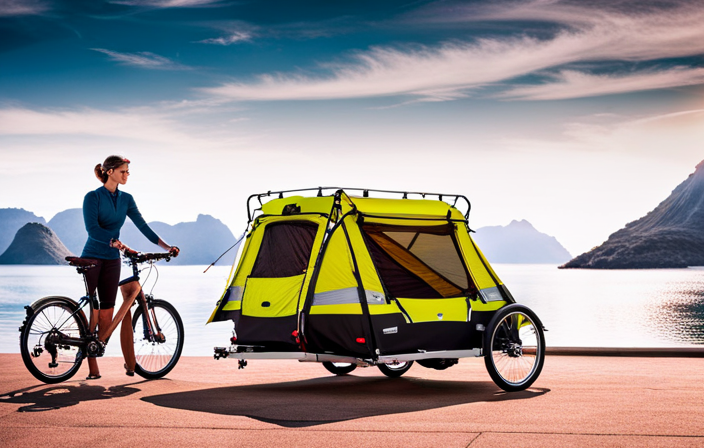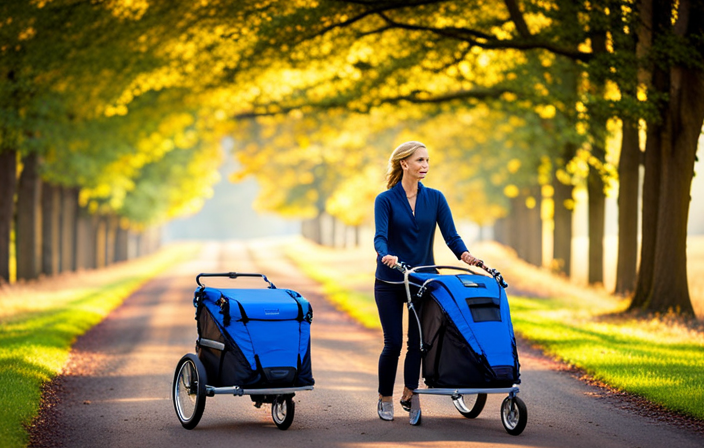Riding with your child in a bicycle trailer can feel like a refreshing breeze on a sunny day, providing a feeling of freedom and excitement.
But when is the right time for babies to ride in bike trailers?
In this article, I will guide you through the safety guidelines, age and developmental milestones, and tips for choosing the right bike trailer.
Let’s ensure a safe and enjoyable journey for both you and your baby.
Key Takeaways
- Follow age recommendations and consult with a pediatrician before allowing babies to ride in bike trailers.
- Ensure proper attachment, weight distribution, and secure strapping of the baby in the trailer.
- Always make sure the baby wears a helmet and consider their overall health before riding.
- Gradually increase the duration of rides and consider developmental milestones for a safe and enjoyable experience.
Understanding the Safety Guidelines for Bike Trailers
To ensure the safety of your child, it’s important to understand the guidelines for using bike trailers.
Bike trailers are a popular choice for parents who want to take their children along on bike rides. They provide a secure and comfortable space for your little one to ride in, while allowing you to enjoy your favorite outdoor activity.
However, it’s crucial to follow the age recommendations and be aware of the potential risks associated with using bike trailers.
Age recommendations for riding in bike trailers vary, but generally, it is recommended that children be at least one year old before riding in a bike trailer. This is because at this age, they have better head and neck control, which is important for their safety. Additionally, it’s important to consider the weight limit of the trailer and ensure that your child falls within the recommended range.
While bike trailers can be a fun and convenient way to include your child in your cycling adventures, there are potential risks to be aware of. One risk is the possibility of tipping over. It’s important to ensure that the trailer is properly attached to your bike and that the weight is distributed evenly. Additionally, always make sure your child is securely strapped into the trailer and that they are wearing a helmet.
Understanding the guidelines for using bike trailers is just the first step in ensuring your child’s safety. In the next section, we will discuss the age and developmental milestones for riding in bike trailers.
Age and Developmental Milestones for Riding in Bike Trailers
By the time they’re able to walk steadily, toddlers can start enjoying the experience of being pulled in a bike trailer. However, it’s important to consider age restrictions and motor skills development before introducing your child to this activity. Bike trailers are designed to provide a safe and comfortable ride for children, but it’s crucial to ensure that they are developmentally ready for the experience.
Here is a table that outlines the age restrictions and motor skills development milestones for riding in bike trailers:
| Age Group | Motor Skills Development Milestones |
|---|---|
| 1-2 years | Able to sit up without support |
| Beginning to walk with assistance | |
| Developing hand-eye coordination | |
| 2-3 years | Walking independently |
| Improving balance skills | |
| Starting to climb and run | |
| 3-4 years | Running and jumping confidently |
| Able to pedal a tricycle | |
| Developing fine motor skills, such as gripping |
It’s important to note that every child develops at their own pace. Before allowing your child to ride in a bike trailer, consult with a pediatrician to ensure they have reached the necessary developmental milestones. This will help ensure their safety and enjoyment while riding in a bike trailer.
Consult with a Pediatrician
Before allowing your child to use a bike trailer, it’s important to consult with a pediatrician to ensure their safety and well-being. Bike trailer safety is paramount, as it involves the transportation of your precious little one on a bicycle. A pediatrician can provide valuable guidance on when it is appropriate for your baby to start riding in a bike trailer, taking into consideration their age, weight, and developmental milestones.
Bike riding has numerous benefits for babies. It helps them develop their motor skills, coordination, and balance. It also provides an opportunity for them to explore the outdoors and experience the world around them. However, it is essential to ensure that your baby is ready for bike riding and that their physical development allows for it.
A pediatrician can assess your baby’s overall health and advise you on the appropriate time to introduce them to a bike trailer. They can also provide recommendations on how to make the experience as safe as possible, such as ensuring proper helmet fit, securing your baby with a harness, and using a trailer that meets safety standards.
Choosing the Right Bike Trailer for Your Baby
When selecting the ideal bike trailer for your little one, it’s crucial to consider factors such as size, weight capacity, and safety features. As a knowledgeable and cautious parent, you want to ensure that your baby’s biking experience is safe and enjoyable.
Here are some key bike trailer features to look for:
-
Size: Choose a trailer that provides enough space for your baby to sit comfortably and securely. Look for adjustable seats and harness systems that can accommodate your child’s growth.
-
Weight Capacity: Consider the weight capacity of the trailer to ensure it can support your baby’s weight as they grow. It’s important to choose a trailer that can handle the combined weight of your baby and any additional items you may need to carry.
-
Safety Features: Look for trailers with a sturdy frame, reliable brakes, and reflective materials for visibility. Also, check for a five-point harness system and a protective canopy to shield your baby from the elements.
Biking with your baby in a trailer offers numerous benefits. It allows you to spend quality time together outdoors while promoting physical activity and fresh air. Additionally, it can be a convenient mode of transportation for running errands or going on family adventures.
With the right bike trailer in hand, you can start enjoying the benefits of biking with your baby. But before you embark on longer rides, it’s important to start with short test rides to ensure that both you and your baby are comfortable and ready for longer journeys.
Start with Short Test Rides
To ensure a smooth and enjoyable experience, it’s important for you to begin with short test rides when introducing your little one to biking in a trailer. This allows you to assess your baby’s comfort and safety, as well as get them accustomed to the motion and sensation of riding in the trailer. When choosing the right bike trailer, make sure it has proper safety features such as a secure harness and sturdy construction. It’s also important to consider the size and weight capacity of the trailer to ensure it can accommodate your growing child.
Starting with short test rides is crucial because it allows you to gradually increase the duration of rides as your baby gets more comfortable. This means that you should initially keep the rides short, maybe just around the block or to a nearby park. This will help your little one become familiar with the trailer and build their confidence over time. It’s important to pay attention to their reactions and adjust the length of the rides accordingly.
Transitioning into longer rides can be done gradually by increasing the distance or duration of each ride. This allows your baby to gradually build up their stamina and tolerance for longer rides. It’s important to listen to your baby and watch for any signs of discomfort or fatigue. Remember, the goal is to make biking in a trailer a fun and enjoyable experience for both you and your little one!
Next, let’s discuss how to gradually increase the duration of rides without overwhelming your baby.
Gradually Increase the Duration of Rides
After getting comfortable with short test rides, it’s time to gradually increase the duration of rides with your baby in the bike trailer. This is an important step in building your baby’s comfort and confidence in the trailer. Here are some tips to help you navigate this process:
-
Start with small increments: Begin by extending the ride duration by just a few minutes each time. This will allow your baby to gradually adapt to longer periods in the trailer without feeling overwhelmed.
-
Observe your baby’s reactions: Pay close attention to your baby’s cues during the rides. Look for signs of discomfort or fatigue, such as fussiness or squirming. If you notice any signs of distress, it’s important to stop and take a break.
-
Choose familiar routes: Stick to routes that your baby is already familiar with. This will help create a sense of familiarity and predictability, which can contribute to their overall comfort.
-
Bring comfort items: To enhance your baby’s comfort during longer rides, consider bringing along their favorite toys, blankets, or snacks. Having these familiar items can provide a sense of security and make the ride more enjoyable for them.
Gradually increasing the ride duration while ensuring your baby’s comfort will help them become more accustomed to being in the bike trailer. With time and patience, your little one will be ready for longer adventures on the road.
Now, let’s explore the importance of riding on smooth and even terrain.
Riding on Smooth and Even Terrain
Choosing smooth and even terrain for your rides will provide a more stable and comfortable experience for you and your little one. When it comes to bike trailer safety, the terrain you choose can make a big difference. Bumpy or uneven surfaces can lead to a rough and jarring ride, potentially causing discomfort or even injury to your child. To ensure a smooth and safe ride, look for bike trailers with features that can help absorb shocks, such as suspension systems or pneumatic tires. These features can provide a smoother ride and minimize the impact of bumps and vibrations.
When riding on smooth and even terrain, it’s important to keep in mind the weight and balance of the trailer. Make sure the trailer is properly attached to your bike and that the weight is evenly distributed. This will help maintain stability and control throughout the ride.
To help you visualize the importance of choosing smooth terrain, here is a table showcasing the potential impact of different types of terrain on your child’s comfort and safety:
| Terrain Type | Impact on Comfort | Impact on Safety |
|---|---|---|
| Smooth | High | Low |
| Bumpy | Low | High |
| Uneven | Low | High |
| Paved | High | Low |
| Off-road | Low | High |
Avoiding Busy Roads and Heavy Traffic
When riding with your child in a bike trailer, it’s crucial to avoid busy roads and heavy traffic for their safety. Here are three reasons why:
-
Minimize distractions: Busy roads and heavy traffic can be overwhelming for young children. The noise, fast-moving vehicles, and constant flow of traffic can easily distract them from enjoying the ride or cause them to become anxious. By choosing quieter routes, you can create a more peaceful and enjoyable experience for your child.
-
Teach road safety: Riding on quieter roads allows you to focus on teaching your child about road safety. You can point out traffic signs, explain the importance of using bike lanes, and demonstrate how to safely cross intersections. These valuable lessons will help your child develop good habits and become more aware of their surroundings when they’re old enough to ride independently.
-
Reduce the risk of accidents: Busy roads and heavy traffic increase the chances of accidents occurring. By avoiding these high-risk areas, you can significantly reduce the likelihood of a collision or injury. Opting for quieter routes, such as residential streets or bike paths, provides a safer environment for you and your child to enjoy your ride.
By following these precautions and choosing safer routes, you can ensure a pleasant and secure ride for both you and your child.
Now, let’s transition to the next section where we’ll discuss dressing your baby appropriately for the ride.
Dressing Your Baby Appropriately for the Ride
It’s important to dress your baby appropriately for the journey to ensure their comfort and safety. When it comes to baby safety, choosing the right clothing is crucial. You want to make sure your little one is protected from the elements while still allowing them to move comfortably in the bike trailer. Here are some tips for dressing your baby for the ride:
| Layer | Description |
|---|---|
| Base Layer | Opt for a moisture-wicking fabric that helps keep your baby dry and comfortable. Look for onesies or bodysuits made from breathable materials such as cotton or bamboo. |
| Insulating Layer | Depending on the weather, add an insulating layer such as a lightweight fleece or sweater. This layer will provide extra warmth without being too bulky. |
| Outer Layer | The outer layer should be windproof and waterproof to protect your baby from rain or chilly winds. Look for a jacket or onesie with a built-in hood to keep their head dry. |
| Accessories | Don’t forget to protect their extremities! Add mittens or gloves, socks or booties, and a hat to keep their hands, feet, and head warm. |
Using Safety Harnesses and Straps
Using safety harnesses and straps in a bike trailer is essential for securing your little one during the ride. As a parent, your child’s safety is of utmost importance, and proper use of seat belts and straps can greatly reduce the risk of accidents or injuries.
Here are some key points to keep in mind when using safety harnesses and straps:
-
Choose a trailer with built-in harnesses: Look for a bike trailer that comes with safety harnesses already installed. This ensures that your child is properly secured and prevents any potential falls or slips.
-
Adjust the straps for a snug fit: Make sure that the straps are adjusted to fit your child snugly. This will prevent them from wiggling or slipping out of the harness during the ride.
-
Secure the straps correctly: Double-check that the straps are fastened securely and that there are no twists or tangles. This ensures that your child is held in place and prevents any chances of them getting loose.
-
Regularly inspect the harnesses: Before each ride, inspect the harnesses for any signs of wear or tear. Replace any damaged straps immediately to maintain their effectiveness.
-
Teach your child about safety: Talk to your child about the importance of staying seated and wearing the safety straps. Encourage them to follow these rules to ensure a safe and enjoyable ride.
Regularly Inspecting and Maintaining the Bike Trailer
Make sure to regularly inspect and maintain your bike trailer to ensure its continued safety and functionality. By following an inspection checklist and adhering to a maintenance schedule, you can identify and address any potential issues before they become major concerns. Here’s a simple table to help you visualize the key areas to inspect and maintain:
| Area | Inspection Checklist |
|---|---|
| Frame | Check for cracks, dents, or signs of wear and tear. |
| Wheels and Tires | Examine tire pressure, tread wear, and wheel alignment. |
| Brakes | Test the effectiveness of the brakes. |
| Hitch and Coupler | Ensure proper attachment to the bike and smooth operation. |
| Suspension | Inspect for any damage or malfunctioning parts. |
| Safety Features | Test the functionality of safety straps and harnesses. |
Regularly following this inspection checklist will help you maintain the safety and functionality of your bike trailer. Additionally, establish a maintenance schedule that includes tasks such as cleaning, lubricating moving parts, and replacing worn-out components. By taking these proactive measures, you can enjoy worry-free rides with your baby.
Now, let’s transition into the next section about keeping an eye on your baby during the ride. It’s essential to ensure your baby’s comfort and safety throughout the journey.
Keeping an Eye on Your Baby During the Ride
While cycling, make sure to regularly check on your little one to ensure their comfort and safety. As a parent, it’s important to prioritize your baby’s comfort during bike rides. Here are some tips to ensure their comfort and well-being:
-
Proper Seating: Make sure your baby is securely strapped into the bike trailer with the proper harness. Adjust the straps to ensure a snug fit without being too tight.
-
Padding and Cushioning: Add extra padding or cushions to the bike trailer to provide a comfortable seating area for your baby. This will help prevent any discomfort or pressure points during the ride.
-
Ventilation: Ensure proper ventilation inside the bike trailer by opening windows or using mesh panels. This will help regulate temperature and prevent your baby from getting too hot or stuffy.
By paying attention to these details, you can provide a comfortable and enjoyable ride for your little one. Remember, a happy and comfortable baby makes for a smoother cycling experience.
As you keep an eye on your baby’s comfort, it’s also crucial to stay alert and be prepared for unexpected situations during your bike ride.
Stay Alert and Be Prepared for Unexpected Situations
Staying alert and being prepared for unexpected situations is crucial while cycling with your baby. As a parent, safety is always my top priority, and that means staying vigilant at all times. Even though I may have taken all the necessary precautions, unforeseen emergencies can still occur. That’s why it’s essential to be prepared for anything that might come our way.
One of the first things I do before heading out on a bike ride with my baby is to ensure that I have all the essential safety gear. This includes a properly fitted helmet for both myself and my little one, as well as reflective clothing and lights to increase visibility. Additionally, I always make sure that the bike trailer or carrier is securely attached to my bike and that all the safety straps are fastened correctly.
While cycling, I constantly scan the road ahead, anticipating any potential hazards or obstacles. I pay close attention to other vehicles, pedestrians, and even animals that may unexpectedly cross our path. I also keep an eye on the weather conditions, as sudden changes can create additional risks.
By staying alert and being prepared for the unexpected, I can ensure that my baby and I have a safe and enjoyable cycling experience.
Now that I’ve covered the importance of staying vigilant, let’s explore how to introduce your baby to the joy of cycling without writing ‘step’.
Introducing Your Baby to the Joy of Cycling
To introduce your little one to the joy of cycling, you can start by taking them on short and leisurely rides in a safe and comfortable environment. One way to do this is by using baby bike seats, which are specially designed to attach to your bicycle and provide a secure and stable seat for your baby. These seats often come with safety features such as harnesses and adjustable straps to ensure your baby’s comfort and protection.
There are several benefits of cycling for babies. Firstly, it allows them to experience the great outdoors and connect with nature from an early age. The fresh air and gentle breeze can be invigorating for their senses and help in their overall development. Secondly, cycling can be a fun and enjoyable way for babies to explore their surroundings. They can observe different sights, sounds, and smells, stimulating their curiosity and cognitive skills. Lastly, cycling can also promote physical exercise and help in building strength and coordination for your little one.
Enjoying Family Bike Rides Safely and Responsibly
Now that you have introduced your baby to the joy of cycling, it’s important to ensure that your family bike rides are safe and responsible. One way to do this is by using a bike trailer, which allows you to bring your little one along on your adventures. However, there are age requirements and safety guidelines that you need to be aware of before putting your baby in a bike trailer.
To help you understand these requirements and guidelines, I have created a table that outlines the age requirements and key safety considerations for bike trailer use:
| Age Range | Safety Considerations |
|---|---|
| 0-12 months | – Ensure that your baby’s neck is strong enough to support a helmet. |
| 1-3 years | – Make sure that your baby can sit up without assistance. |
| 3+ years | – Teach your child how to wear a helmet properly. |
| All ages | – Choose a bike trailer that meets safety standards and has a secure harness system. |
| – Always follow the manufacturer’s instructions for proper installation and use. | |
| – Check the trailer’s tires, brakes, and other components regularly for wear and tear. | |
| – Be cautious of traffic and choose bike paths or quiet roads for your rides. |
Frequently Asked Questions
Can I use a bike trailer for my newborn baby?
Yes, you can use a bike trailer for your newborn baby. However, it is important to wait until your baby is at least 6-9 months old and has good neck and head control. This ensures their safety and comfort during the ride.
It is also recommended to consult with your pediatrician before using a bike trailer. Remember to always follow the manufacturer’s guidelines and use proper safety gear, such as a helmet, for your little one.
Are there any weight restrictions for using a bike trailer with a baby?
There are weight restrictions and age requirements for using a bike trailer with a baby. It is important to follow these guidelines to ensure the safety of your child.
Most bike trailers have a maximum weight capacity of around 75 pounds, so it is important to check the specifications of your specific trailer. Additionally, it is recommended that babies be at least 12 months old before riding in a bike trailer, as their neck muscles need to be strong enough to support their head.
Can I use a bike trailer with multiple children?
Yes, you can use a bike trailer with multiple children. It provides a safe and convenient way to transport your kids while cycling.
However, it’s important to ensure that the weight of the children does not exceed the trailer’s weight limit.
Additionally, using bike trailers for pets is also possible, but make sure to choose a trailer specifically designed for pets.
Consider adding bike trailer accessories for added comfort, such as padded seats or sunshades.
Are there any specific safety features I should look for in a bike trailer for my baby?
I know you may be concerned about the safety of using a bike trailer for your baby, but rest assured, there are specific safety features you should look for.
First, ensure that the bike trailer meets all bike trailer safety regulations.
Additionally, proper installation is crucial to ensure your baby’s safety.
Look for features such as a secure harness system, a sturdy frame, and a low center of gravity for added stability.
Always prioritize your baby’s safety when choosing a bike trailer.
How can I ensure that my baby stays comfortable during bike rides in a trailer?
To ensure my baby stays comfortable during bike rides in a trailer, I make sure to dress them in appropriate clothing that is suitable for the weather.
I also ensure that the trailer has proper padding to provide a cushioned and comfortable ride for my little one. This helps to prevent any discomfort or irritation during our bike adventures.
Keeping my baby’s comfort in mind is crucial for a pleasant and enjoyable ride.
Conclusion
In conclusion, it is important to follow the safety guidelines when considering when babies can ride in bike trailers. Consulting with a pediatrician is crucial to ensure that your baby is developmentally ready.
Additionally, choosing the right bike trailer and starting with short test rides can help ensure a safe experience. Remember to keep an eye on your baby during the ride and stay alert for unexpected situations.
Introducing your baby to the joy of cycling can be a wonderful experience, but it is important to prioritize safety and responsibility. As the saying goes, ‘just as a caterpillar needs time in its cocoon to transform into a butterfly, babies need time and proper precautions to safely enjoy the world of bike trailers.’
So, let’s embark on this journey together, keeping our little ones safe and cherishing the memories we create along the way.
